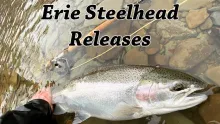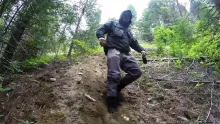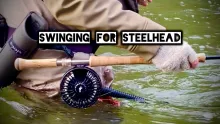The mortality rate for a steelhead taken out of the water for 60 seconds or even 10 seconds can have huge implications on a fishes survival.
The fish you thought swam off to provide a kick for the next generation might actually turn out to be a floater downstream.
The information I present in this article is becoming more important due to extreme temperatures from drought related causes. At a certain point, you have to ask yourself if it's ethical to fish for steelhead when the water is above a certain temperature. At 70 degrees and above, bag it.
I know what all of you cold weather anglers are thinking... "we don't have warm temps!" This article is about more than temperatures. It's about how to assure survival and success for the next generation of fish by how you land, handle and release the fish.
For example, How long should it take you to play, land and release a steelhead- is 5 minutes too long? How about 10... 20? We obviously want to get the fish in, but does it make sense to play that fish all the way out? Did you take the fish out of the water? Do you know the risks to these fish from air exposure?
There's plenty of research that suggests increased mortality rates from improper fighting, landing and releasing practices. This study by Ferguson describes the effects from even brief air exposure and implications to post release fish mortality.
There are things you can do to land the fish quicker and decrease the above mentioned impacts.
Let's go through the process from when the fish is hooked until when it's leaving your hands and talk about what you can do to assure that fish survives to see that next spawning bed. This all means more fish for the next generation and for you. Let's get into it.
Playing a steelhead
You will be battling one of the hottest freshwater game fishes in the country. So, how long should it take to land one, and how do you play one to reduce stress? Timing is a challenging question, without a clear answer. But, if you make sure to keep the pressure on and land them as soon as possible, you'll be off to a good start.
Use a heavier tippet to help land the fish quicker. A minimum of 10 or 12 lb tippet should be used, but go heavier whenever possible.
Here are a few additional tips: If the fish is running on you, it's a good idea to follow it down river. By following it (wading downstream usually), you will be able to more quickly turn the fish into the bank and get him out of the middle of the river.
(I love that first run, when I realize the fish is going down river- It gets my blood pumping and I'm fired up for the game.)
Keep constant pressure on the fish and turn him to the side by bending your rod towards the bank you're fishing from. You should be putting constant pressure on and pumping the fish. To pump a fish, reel down to the fish, then take your hand off the reel and pull the rod back towards the bank. Then reel back down to the fish, dropping your rod tip towards the fish and water. Pumping the fish is a great way to bring the fish in, and minimizes the potential to break him off.
Once the fish tires and turns into the bank, keep it coming in with constant pressure. Try to find a moderately shallow area where you can handle him in the water. Note: Be ready towards the end when the fish is in close as they will try to make one last run on you.
Landing a Steelhead
As the fish comes in, keeping tension on the fly, grab the caudal peduncle (the back end of the body in front of the tail), keep a firm but easy grip on the peduncle and gently put your other hand under the fish but don't squeeze the belly as this can damage internal organs and affect survival. Then, remove the fly, keeping the fish in the water.
The most important thing for assuring their survival is to KEEP THEM IN THE WATER. The best spot to land a fish is in water that is deep enough to cover their body, but doesn't give them a lot of room to run on you. A moderate depth gravel tail-out is better than a deep pool.
Remember to reduce handling time whenever possible. If you have a good knotless catch and release net, use that with help from a partner if possible.
I've seen a lot of people talking about not grabbing the gills, so I'll briefly talk about it: Don't do it! The gills allow the fish to breath and are very susceptible to damage if touched by outside sources. Even a mild abrasion can have major implications for survival.
Have your pliers ready in case the fly is buried in the mouth, and if you have to take a picture, keep him in the water if possible. If you pull the fish out of the water, keep it under 5 seconds.
Releasing a Steelhead
After you've removed the fly, get a feel for the fishes recovery status. If you played it for a while you may have to hold it in the water for a longer period to allow it to recover. A poorly recovering fish will have trouble keeping itself upright and will be moving it gills rapidly. If let go at this point, it will likely just turn belly up and float downstream.
Wait until you feel the momentum of the tail or the feel of the body tense before you release her. These are both signs that she's ready to go.
Trout Unlimited cites a number of articles that talk about direct mortality relating to some of the concerns I've addressed here. Check out this video that shows you how to land a steelhead. Now, it is up to you - you know what you need to do and their survival is dependent on your proper technique. Remember: Get them in quickly, keep ‘em wet, and keep handling to a minimum.
Conclusion
As a fisherman, it's thought you have an ethical right to understand proper handling techniques for wild fish. Follow the tips I've given you for the proper play, land and release of a wild steelhead. Both of the videos will give you a great visual of how to do it right. Do you fish for other species that might benefit from these same practices? Leave a comment below for the tip that resonates most with you.
- Log in to post comments











